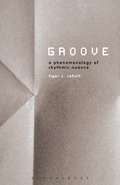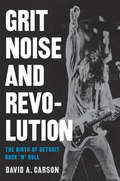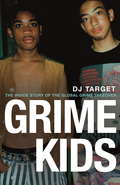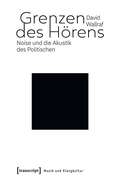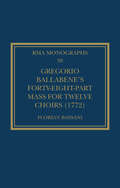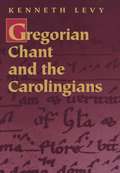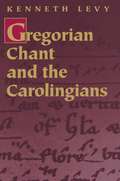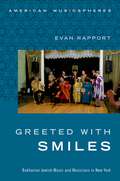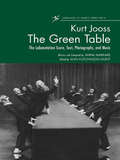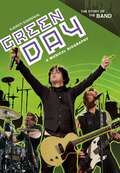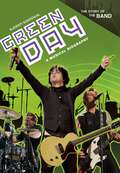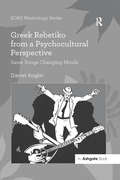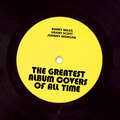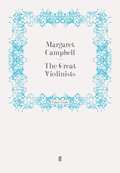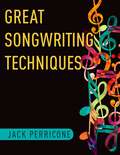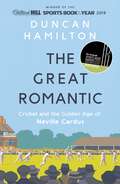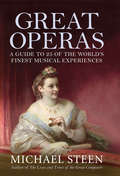- Table View
- List View
Groove: A Phenomenology of Rhythmic Nuance
by Tiger C. RoholtWritten by an experienced drummer and philosopher, Groove is a vivid and exciting study of one of music's most central and relatively unexplored aspects. Tiger C. Roholt explains why grooves, which are forged in music's rhythmic nuances, remain hidden to some listeners. He argues that grooves are not graspable through the intellect nor through mere listening; rather, grooves are disclosed through our bodily engagement with music. We grasp a groove bodily by moving with music's pulsations. By invoking the French philosopher Maurice Merleau-Ponty's notion of "motor intentionality," Roholt shows that the "feel" of a groove, and the understanding of it, are two sides of a coin: to "get" a groove just is to comprehend it bodily and to feel that embodied comprehension.
Groove: A Phenomenology of Rhythmic Nuance
by Tiger C. RoholtWritten by an experienced drummer and philosopher, Groove is a vivid and exciting study of one of music's most central and relatively unexplored aspects. Tiger C. Roholt explains why grooves, which are forged in music's rhythmic nuances, remain hidden to some listeners. He argues that grooves are not graspable through the intellect nor through mere listening; rather, grooves are disclosed through our bodily engagement with music. We grasp a groove bodily by moving with music's pulsations. By invoking the French philosopher Maurice Merleau-Ponty's notion of "motor intentionality," Roholt shows that the "feel" of a groove, and the understanding of it, are two sides of a coin: to "get" a groove just is to comprehend it bodily and to feel that embodied comprehension.
Grit, Noise, and Revolution: The Birth of Detroit Rock 'n' Roll
by David A. Carson". . . a great blow-by-blow account of an exciting and still-legendary scene." ---Marshall Crenshaw From the early days of John Lee Hooker to the heyday of Motown and beyond, Detroit has enjoyed a long reputation as one of the crucibles of American pop music. In Grit, Noise, and Revolution, David Carson turns the spotlight on those hard-rocking, long-haired musicians-influenced by Detroit's R&B heritage-who ultimately helped change the face of rock 'n' roll. Carson tells the story of some of the great garage-inspired, blue-collar Motor City rock 'n' roll bands that exemplified the Detroit rock sound: The MC5, Iggy Pop and the Stooges, Mitch Ryder and the Detroit Wheels, SRC, the Bob Seger System, Ted Nugent and the Amboy Dukes, and Grand Funk Railroad. An indispensable guide for rock aficionados, Grit, Noise, and Revolution features stories of these groundbreaking groups and is the first book to survey Detroit music of the 1960s and 70s-a pivotal era in rock music history.
Grime Kids: The Inside Story of the Global Grime Takeover
by DJ TargetAn explosive insider account of grime, from subculture to international phenomenon. *****A group of kids in the 2000s had a dream to make their voice heard - and this book documents their seminal impact on today's pop culture.DJ Target grew up in Bow under the shadow of Canary Wharf, with money looming close on the skyline. The 'Godfather of Grime' Wiley and Dizzee Rascal first met each other in his bedroom. They were all just grime kids on the block back then, and didn't realise they were to become pioneers of an international music revolution. A movement that permeates deep into British culture and beyond. Household names were borne out of those housing estates, and the music industry now jumps to the beat of their gritty reality rather than the tune of glossy aspiration. Grime has shaken the world and Target is revealing its explosive and expansive journey in full, using his own unique insight and drawing on the input of grime's greatest names.
Grétry's Operas and the French Public: From the Old Regime to the Restoration (Ashgate Interdisciplinary Studies in Opera)
by R.J. ArnoldWhy, in the dying days of the Napoleonic Empire, did half of Paris turn out for the funeral of a composer? The death of André Ernest Modeste Grétry in 1813 was one of the sensations of the age, setting off months of tear-stained commemorations, reminiscences and revivals of his work. To understand this singular event, this interdisciplinary study looks back to Grétry’s earliest encounters with the French public during the 1760s and 1770s, seeking the roots of his reputation in the reactions of his listeners. The result is not simply an exploration of the relationship between a musician and his audiences, but of developments in musical thought and discursive culture, and of the formation of public opinion over a period of intense social and political change. The core of Grétry’s appeal was his mastery of song. Distinctive, direct and memorable, his melodies were exported out of the opera house into every corner of French life, serving as folkloristic tokens of celebration and solidarity, longing and regret. Grétry’s attention to the subjectivity of his audiences had a profound effect on operatic culture, forging a new sense of democratic collaboration between composer and listener. This study provides a reassessment of Grétry’s work and musical thought, positioning him as a major figure who linked the culture of feeling and the culture of reason - and who paved the way for Romantic notions of spectatorial absorption and the power of music.
Grétry's Operas and the French Public: From the Old Regime to the Restoration (Ashgate Interdisciplinary Studies in Opera)
by R.J. ArnoldWhy, in the dying days of the Napoleonic Empire, did half of Paris turn out for the funeral of a composer? The death of André Ernest Modeste Grétry in 1813 was one of the sensations of the age, setting off months of tear-stained commemorations, reminiscences and revivals of his work. To understand this singular event, this interdisciplinary study looks back to Grétry’s earliest encounters with the French public during the 1760s and 1770s, seeking the roots of his reputation in the reactions of his listeners. The result is not simply an exploration of the relationship between a musician and his audiences, but of developments in musical thought and discursive culture, and of the formation of public opinion over a period of intense social and political change. The core of Grétry’s appeal was his mastery of song. Distinctive, direct and memorable, his melodies were exported out of the opera house into every corner of French life, serving as folkloristic tokens of celebration and solidarity, longing and regret. Grétry’s attention to the subjectivity of his audiences had a profound effect on operatic culture, forging a new sense of democratic collaboration between composer and listener. This study provides a reassessment of Grétry’s work and musical thought, positioning him as a major figure who linked the culture of feeling and the culture of reason - and who paved the way for Romantic notions of spectatorial absorption and the power of music.
Grenzen des Hörens: Noise und die Akustik des Politischen (Musik und Klangkultur #51)
by David WallrafWas ist der Klang der Macht? Wie verschafft sich Widerstand Gehör? In Grenzen des Hörens widmet sich David Wallraf jenen verdrängten Seiten des Hörbaren, die als Lärm, Rauschen, Geräusche und Störungen vernehmbar werden. Ausgehend von Noise als einem subkulturellen Genre, das die traditionellen Parameter der Musik dekonstruiert, zeichnet er den Begriff bis in Diskurse der Akustik, Thermodynamik und Informationstheorie nach und entwirft dabei eine politisch-ästhetische Theorie des Auditiven. Vor dem Hintergrund seiner Praxis als experimenteller Noise-Künstler legt er mit seiner kenntnisreichen und äußerst lesbaren Abhandlung eine kritische Ergänzung zu den Sound Studies vor.
Gregorio Ballabene’s Forty-eight-part Mass for Twelve Choirs (Royal Musical Association Monographs)
by Florian BassaniNeither Spem in alium, the widely acclaimed ‘songe of fortie partes’ by Thomas Tallis, nor Alessandro Striggio’s forty-part Mass is the largest-scale counterpoint work in Western music. The actual winner is Gregorio Ballabene, a relatively unknown Roman maestro di cappella, a contemporary of Giovanni Paisiello, Joseph Haydn and Luigi Boccherini, who composed in forty-eight parts for twelve choirs. His Mass saw only a public rehearsal and was never performed liturgically despite all of Ballabene’s efforts to promote it. On closer inspection, however, the work deserves special consideration as a piece of outstanding combinatory creativity – the product of a talent able to conceive, structure and realise a project of colossal dimensions. It might even be claimed that if Charles Burney had gained knowledge of it, all derogatory comments by nineteenth-century music historians would not have succeeded in extinguishing the interest of later generations. Ballabene’s Mass has remained completely unstudied until today, even though the score survives in prominent collections. This study offers, for the first time, a historical and analytical perspective on this overlooked manifestation of a very individual musical intelligence.
Gregorio Ballabene’s Forty-eight-part Mass for Twelve Choirs (Royal Musical Association Monographs)
by Florian BassaniNeither Spem in alium, the widely acclaimed ‘songe of fortie partes’ by Thomas Tallis, nor Alessandro Striggio’s forty-part Mass is the largest-scale counterpoint work in Western music. The actual winner is Gregorio Ballabene, a relatively unknown Roman maestro di cappella, a contemporary of Giovanni Paisiello, Joseph Haydn and Luigi Boccherini, who composed in forty-eight parts for twelve choirs. His Mass saw only a public rehearsal and was never performed liturgically despite all of Ballabene’s efforts to promote it. On closer inspection, however, the work deserves special consideration as a piece of outstanding combinatory creativity – the product of a talent able to conceive, structure and realise a project of colossal dimensions. It might even be claimed that if Charles Burney had gained knowledge of it, all derogatory comments by nineteenth-century music historians would not have succeeded in extinguishing the interest of later generations. Ballabene’s Mass has remained completely unstudied until today, even though the score survives in prominent collections. This study offers, for the first time, a historical and analytical perspective on this overlooked manifestation of a very individual musical intelligence.
Gregorian Chant and the Carolingians
by Kenneth LevyA world-renowned scholar of plainchant, Kenneth Levy has spent a portion of his career investigating the nature and ramifications of this repertory's shift from an oral tradition to the written versions dating to the tenth century. In Gregorian Chant and the Carolingians, which represents the culmination of his research, Levy seeks to change long-held perceptions about certain crucial stages of the evolution and dissemination of the old corpus of plainchant--most notably the assumption that such a large and complex repertory could have become and remained fixed for over a century while still an oral tradition. Levy portrays the promulgation of an authoritative body of plainchant during the reign of Charlemagne by clearly differentiating between actual evidence, hypotheses, and received ideas. How many traditions of oral chant existed before the tenth century? Among the variations noted in written chant, can one point to a single version as being older or more authentic than the others? What precursors might there have been to the notational system used in all the surviving manuscripts, where the notational system seems fully formed and mature? In answering questions that have long vexed many scholars of Gregorian chant's early history, Levy offers fresh explanations of such topics as the origin of Latin neumes, the shifting relationships between memory and early notations, and the puzzling differences among the first surviving neume-species from the tenth century, which have until now impeded a critical restoration of the Carolingian musical forms.
Gregorian Chant and the Carolingians
by Kenneth LevyA world-renowned scholar of plainchant, Kenneth Levy has spent a portion of his career investigating the nature and ramifications of this repertory's shift from an oral tradition to the written versions dating to the tenth century. In Gregorian Chant and the Carolingians, which represents the culmination of his research, Levy seeks to change long-held perceptions about certain crucial stages of the evolution and dissemination of the old corpus of plainchant--most notably the assumption that such a large and complex repertory could have become and remained fixed for over a century while still an oral tradition. Levy portrays the promulgation of an authoritative body of plainchant during the reign of Charlemagne by clearly differentiating between actual evidence, hypotheses, and received ideas. How many traditions of oral chant existed before the tenth century? Among the variations noted in written chant, can one point to a single version as being older or more authentic than the others? What precursors might there have been to the notational system used in all the surviving manuscripts, where the notational system seems fully formed and mature? In answering questions that have long vexed many scholars of Gregorian chant's early history, Levy offers fresh explanations of such topics as the origin of Latin neumes, the shifting relationships between memory and early notations, and the puzzling differences among the first surviving neume-species from the tenth century, which have until now impeded a critical restoration of the Carolingian musical forms.
Greeted With Smiles: Bukharian Jewish Music and Musicians in New York (American Musicspheres)
by Evan RapportAs the Soviet Union stood on the brink of collapse, thousands of Bukharian Jews left their homes from across the predominantly Muslim cities of Central Asia, to reestablish their lives in the United States, Israel and Europe. Today, about thirty thousand Bukharian Jews reside in New York City, settled into close-knit communities and existing as a quintessential American immigrant group. For Bukharian immigrants, music is an essential part of their communal self-definition, and musicians frequently act as cultural representatives for the group as a whole. Greeted with Smiles: Bukharian Jewish Music and Musicians in New York explores the circumstances facing new American immigrants, using the music of the Bukharian Jews to gain entrance into their community and their culture. Author Evan Rapport investigates the transformation of Bukharian identity through an examination of corresponding changes in its music, focusing on three of these distinct but overlapping repertoires - maqom (classical or "heavy" music), Jewish religious music and popular party (or "light") music. Drawing upon interviews, participant observation and music lessons, Rapport interprets the personal perspectives of musicians who serve as community leaders and representatives. By adapting strategies acquired as an ethno-religious minority among Central Asian Muslim neighbors, Bukharian musicians have adjusted their musical repertoire in their new American home. The result is the creation of a distinct Bukharian Jewish American identity-their musical activities are changing the city's cultural landscape while at the same time providing for an understanding of the cultural implications of Bukharian diaspora. Greeted with Smiles is sure to be an essential text for ethnomusicologists and scholars of Jewish and Central Asian music and culture, Jewish-Muslim interaction and diasporic communities.
Greeted With Smiles: Bukharian Jewish Music and Musicians in New York (American Musicspheres)
by Evan RapportAs the Soviet Union stood on the brink of collapse, thousands of Bukharian Jews left their homes from across the predominantly Muslim cities of Central Asia, to reestablish their lives in the United States, Israel and Europe. Today, about thirty thousand Bukharian Jews reside in New York City, settled into close-knit communities and existing as a quintessential American immigrant group. For Bukharian immigrants, music is an essential part of their communal self-definition, and musicians frequently act as cultural representatives for the group as a whole. Greeted with Smiles: Bukharian Jewish Music and Musicians in New York explores the circumstances facing new American immigrants, using the music of the Bukharian Jews to gain entrance into their community and their culture. Author Evan Rapport investigates the transformation of Bukharian identity through an examination of corresponding changes in its music, focusing on three of these distinct but overlapping repertoires - maqom (classical or "heavy" music), Jewish religious music and popular party (or "light") music. Drawing upon interviews, participant observation and music lessons, Rapport interprets the personal perspectives of musicians who serve as community leaders and representatives. By adapting strategies acquired as an ethno-religious minority among Central Asian Muslim neighbors, Bukharian musicians have adjusted their musical repertoire in their new American home. The result is the creation of a distinct Bukharian Jewish American identity-their musical activities are changing the city's cultural landscape while at the same time providing for an understanding of the cultural implications of Bukharian diaspora. Greeted with Smiles is sure to be an essential text for ethnomusicologists and scholars of Jewish and Central Asian music and culture, Jewish-Muslim interaction and diasporic communities.
The Green Table: The Labanotation Score, Text, Photographs, and Music
by Ann Hutchinson Guest* Score, photographs, and production details of one of this century's best-loved ballets * Includes rare archival material * Packaged with audio CD This work brings together the complete dance score of The Green Table--one of the most famous ballets of the 20th century--in Labanotation, along with music notation for the piano accompaniment and a complete recording of the accompaniment on CD. It also includes several essays about the work and its genesis, and many historic production photographs. This book is an important item for all colleges with dance programs to own in their libraries and for scholars interested in the study of contemporary dance.
The Green Table: The Labanotation Score, Text, Photographs, and Music
by Ann Hutchinson Guest* Score, photographs, and production details of one of this century's best-loved ballets * Includes rare archival material * Packaged with audio CD This work brings together the complete dance score of The Green Table--one of the most famous ballets of the 20th century--in Labanotation, along with music notation for the piano accompaniment and a complete recording of the accompaniment on CD. It also includes several essays about the work and its genesis, and many historic production photographs. This book is an important item for all colleges with dance programs to own in their libraries and for scholars interested in the study of contemporary dance.
Green Day: A Musical Biography (The Story of the Band)
by Kjersti EgerdahlHere is an up-to-date, thoroughly researched biography of the world's most popular pop-punk band.Green Day is almost certainly the world's most popular pop-punk band. How they got there is the subject of Green Day: A Musical Biography, the first book to follow the band from their beginnings through the spring 2009 release of 21st Century Breakdown. Tracing the band's evolution from fiercely independent punks to a global powerhouse, Green Day starts with the members' earliest musical influences and upbringing and the founding of the punk club 924 Gilman Street that shaped their sense of community. Discussion of their conflicted feelings about signing to a major label explores the classic rock 'n' roll conundrum of "selling out," while details of their decline and 2004 rebirth offer an inspirational story of artistic rejuvenation. Interviews with the band members and key figures in their lives, excerpted from punk 'zines and other publications, offer a perspective on their methods of self-promotion and the image they have chosen to project over time.
Green Day: A Musical Biography (The Story of the Band)
by Kjersti EgerdahlHere is an up-to-date, thoroughly researched biography of the world's most popular pop-punk band.Green Day is almost certainly the world's most popular pop-punk band. How they got there is the subject of Green Day: A Musical Biography, the first book to follow the band from their beginnings through the spring 2009 release of 21st Century Breakdown. Tracing the band's evolution from fiercely independent punks to a global powerhouse, Green Day starts with the members' earliest musical influences and upbringing and the founding of the punk club 924 Gilman Street that shaped their sense of community. Discussion of their conflicted feelings about signing to a major label explores the classic rock 'n' roll conundrum of "selling out," while details of their decline and 2004 rebirth offer an inspirational story of artistic rejuvenation. Interviews with the band members and key figures in their lives, excerpted from punk 'zines and other publications, offer a perspective on their methods of self-promotion and the image they have chosen to project over time.
Greek Rebetiko from a Psychocultural Perspective: Same Songs Changing Minds (SOAS Studies in Music Series)
by Daniel KoglinGreek Rebetiko from a Psychocultural Perspective: Same Songs Changing Minds examines the ways in which audiences in present-day Greece and Turkey perceive and use the Greek popular song genre rebetiko to cultivate specific cultural habits and identities. In the past, rebetiko has been associated chiefly with the lower strata of Greek society. But Daniel Koglin approaches the subject from a different perspective, exploring the mythological and ritual aspects of rebetiko, which intellectual elites on both sides of the Aegean Sea have adapted to their own world views in our age of globalized consumption. Combining qualitative and quantitative methods from ethnomusicology, ritual studies, conceptual history and music psychology, Koglin casts light on the role played by national perceptions in the processes of music production and consumption. His analysis reveals that rebetiko persistently oscillates between conceptual categories: it is a music both ours and theirs, marginal and mainstream, joyful and grievous, sacred and profane. The study culminates in the thesis that this semantic multistability is not only a key concept to understanding the ongoing popularity of rebetiko in Greece, and its recent renaissance in Turkey, but also a fundamental aspect of the human experience on the south-eastern borders of Europe.
Greek Rebetiko from a Psychocultural Perspective: Same Songs Changing Minds (SOAS Studies in Music Series)
by Daniel KoglinGreek Rebetiko from a Psychocultural Perspective: Same Songs Changing Minds examines the ways in which audiences in present-day Greece and Turkey perceive and use the Greek popular song genre rebetiko to cultivate specific cultural habits and identities. In the past, rebetiko has been associated chiefly with the lower strata of Greek society. But Daniel Koglin approaches the subject from a different perspective, exploring the mythological and ritual aspects of rebetiko, which intellectual elites on both sides of the Aegean Sea have adapted to their own world views in our age of globalized consumption. Combining qualitative and quantitative methods from ethnomusicology, ritual studies, conceptual history and music psychology, Koglin casts light on the role played by national perceptions in the processes of music production and consumption. His analysis reveals that rebetiko persistently oscillates between conceptual categories: it is a music both ours and theirs, marginal and mainstream, joyful and grievous, sacred and profane. The study culminates in the thesis that this semantic multistability is not only a key concept to understanding the ongoing popularity of rebetiko in Greece, and its recent renaissance in Turkey, but also a fundamental aspect of the human experience on the south-eastern borders of Europe.
The Greatest Album Covers of All Time
by Barry Miles Grant Scott Johnny MorganWith the resurgence of vinyl going from strength to strength, album cover art is as important as it's ever been. This sumptuous book brings together 250 of the greatest album covers of all time and is arranged chronologically, beginning in 1956. Our judging panel, drawn from the great and the good of the music industry, has selected the final 275 entries, giving their reasons for selection to accompany the illustrations. From rock ‘n’ roll to pop, R&B to jazz, blues and even folk, some of the album covers included are obvious classics, while others will surprise readers and jog memories. The chosen entries might not necessarily be of a best-selling release, but they are important artistically, stylistically or culturally. This fascinating book forms a wonderful visual record of this popular art form, and is an essential read for music fans the world over.
The Great Violinists (Great Musicians #2)
by Margaret CampbellThis carefully researched and definitive book recreates the magic of the greatest violinists in history. In three centuries, the solo performer progressed from downtrodden private servant to revered public idol. The supreme artists Corelli, Vivaldi, Viotti, Paganini, Vieuxtemps, Joachim and Auer were pivotal figures in the history of violin playing, while more recent times have seen Sarasate, Ysaye and the virtuosi of the modern recording era. The Great Violinists reveals a range of personalities from the conventional to the eccentric. In her coverage of the last hundred years, Margaret Campbell has interviewed many eminent musicians and had rich access to letters and private documents. Her book offers a vivid portrait of skills and traditions that have been handed down through generations. It is a book for string players, students, concert goers and music buffs - indeed, anyone who enjoys the sound of the violin.
GREAT SONGWRITING TECHNIQUES C
by Jack PerriconeIn Great Songwriting Techniques, veteran composer and teacher Jack Perricone shares years of experience in the art, science, and pedagogy of songwriting to teach readers the craft. Whether they write for a small group of friends or in the hopes of creating a smash hit, aspiring songwriters can learn how to focus on topics essential to their success in this competitive field; every songwriter must be aware of audience, thick-skinned enough to handle rejection and competition, and most importantly have the confidence to master the craft of composing and producing. Perricone teaches readers to accomplish this through a targeted series of lessons on key elements of songwriting from building blocks like melody, harmony, and rhythm to more advanced topics like lyric placement and tone texture. Chapters explore loop-based harmonic patterns, tone tendencies, form, function, and lyric writing, all in service of preparing the aspiring songwriter to be a master of prosody and keen in understanding the relationship between words and music. The volume includes examples of exceptional songwriting from well-known artists such as Irving Berlin, Prince, Bob Dylan, Stevie Wonder, Justin Timberlake, and Taylor Swift.
Great Songwriting Techniques
by Jack PerriconeIn Great Songwriting Techniques, veteran composer and teacher Jack Perricone shares years of experience in the art, science, and pedagogy of songwriting to teach readers the craft. Whether they write for a small group of friends or in the hopes of creating a smash hit, aspiring songwriters can learn how to focus on topics essential to their success in this competitive field; every songwriter must be aware of audience, thick-skinned enough to handle rejection and competition, and most importantly have the confidence to master the craft of composing and producing. Perricone teaches readers to accomplish this through a targeted series of lessons on key elements of songwriting from building blocks like melody, harmony, and rhythm to more advanced topics like lyric placement and tone texture. Chapters explore loop-based harmonic patterns, tone tendencies, form, function, and lyric writing, all in service of preparing the aspiring songwriter to be a master of prosody and keen in understanding the relationship between words and music. The volume includes examples of exceptional songwriting from well-known artists such as Irving Berlin, Prince, Bob Dylan, Stevie Wonder, Justin Timberlake, and Taylor Swift.
The Great Romantic: Cricket and the golden age of Neville Cardus - Winner of the William Hill Sports Book of the Year
by Duncan HamiltonNeville Cardus described how one majestic stroke-maker 'made music' and 'spread beauty' with his bat. Between two world wars, he became the laureate of cricket by doing the same with words.In The Great Romantic, award-winning author Duncan Hamilton demonstrates how Cardus changed sports journalism for ever. While popularising cricket - while appealing, in Cardus' words to people who 'didn't know a leg-break from the pavilion cat at Lord's'- he became a star in his own right with exquisite phrase-making, disdain for statistics and a penchant for literary and musical allusions. Among those who venerated Cardus were PG Wodehouse, John Arlott, Harold Pinter, JB Priestley and Don Bradman. However, behind the rhapsody in blue skies, green grass and colourful characters, this richly evocative biography finds that Cardus' mother was a prostitute, he never knew his father and he received negligible education. Infatuations with younger women ran parallel to a decidedly unromantic marriage. And, astonishingly, the supreme stylist's aversion to factual accuracy led to his reporting on matches he never attended. Yet Cardus also belied his impoverished origins to prosper in a second class-conscious profession, becoming a music critic of international renown. The Great Romantic uncovers the dark enigma within a golden age.
Great Operas: A Guide to Twenty-Five of the World's Finest Musical Experiences (Great Operas)
by Michael SteenWith four famous operas each from Mozart, Verdi and Puccini, and two each from Rossini and Donizetti, there is a feast of information. Here are short guides to The Marriage of Figaro and Don Giovanni; to the splendour of Aïda, the heart-breaking La Traviata; the drama of Tosca. The range is very broad. There is Wagner’s great love story Tristan und Isolde; there is Johann Strauss’s light comedy Die Fledermaus. On the way you can be briefed about such favourites as Handel’s Giulio Cesare, Bizet’s Carmen, Gounod’s Faust, Tchaikovsky’s Eugene Onegin and Britten’s Peter Grimes. With plot summaries, composer biographies, observations on musical points of interest and background on the historical and cultural context of each opera, every one of these guides will enhance your appreciation and enjoyment and help you discuss the work and the performance with your fellow opera-goers. Steen shares his expert knowledge with a lightness of touch that makes each guide a pleasure to read. Witty, informative and beautifully presented, Great Operas is an indispensable reference guide for both seasoned opera-goers and those enjoying opera for the first time.
